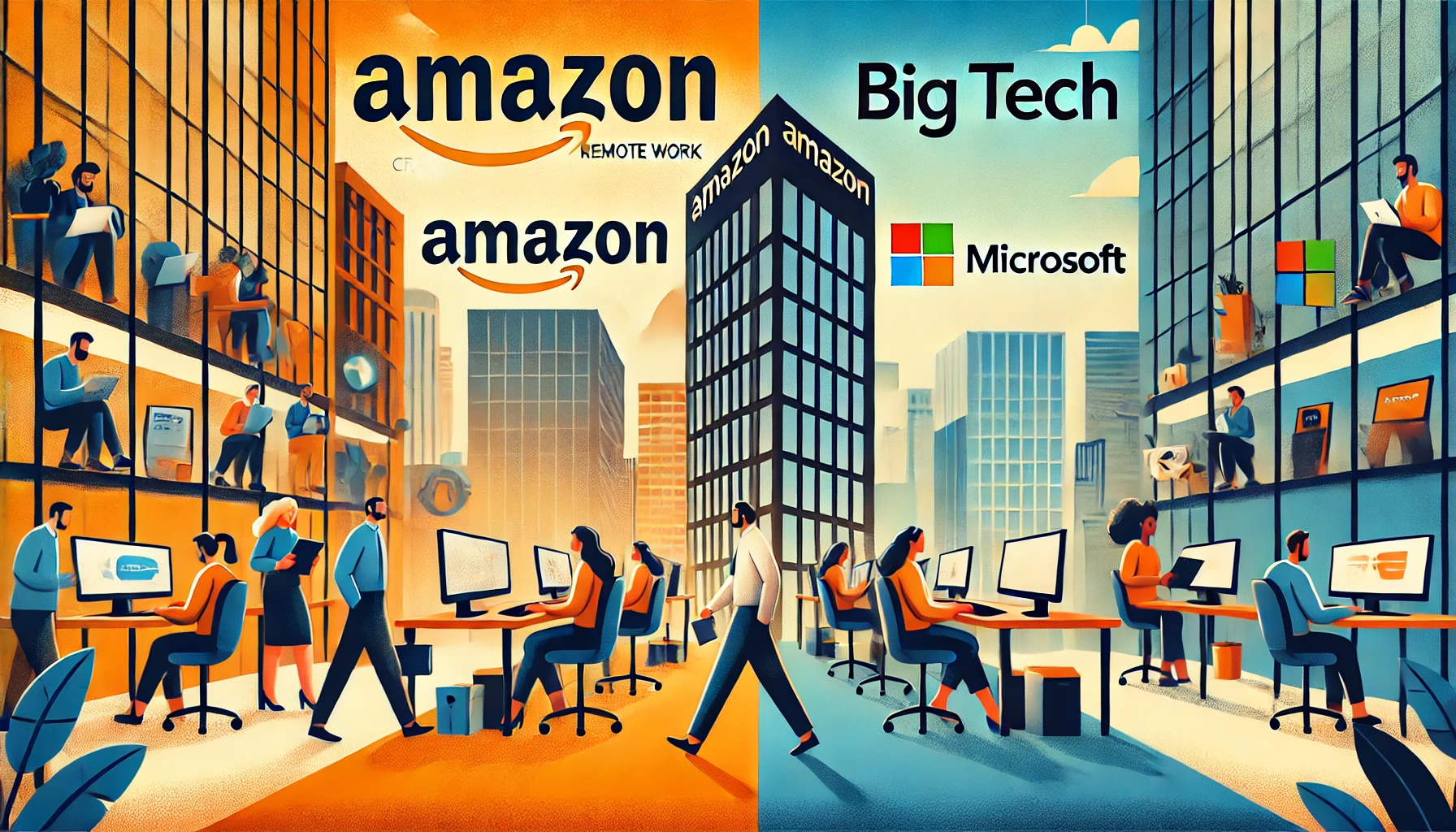Amazon’s Crackdown on Remote Work: Contrasting Big Tech’s Softer Approach and the Impact on the Workforce
The landscape of remote work has been a hotly debated topic since the onset of the COVID-19 pandemic. Many industries, particularly Big Tech, swiftly transitioned to remote or hybrid work models to adapt to the challenges posed by lockdowns and safety concerns. Fast forward to 2024, and we see a sharp divergence in approaches. Amazon’s remote work policy has recently taken a stricter turn, as the company pushes for a return-to-office mandate, while other major tech firms like Google, Meta, and Microsoft have adopted a more flexible approach. This growing rift between Amazon and its peers is stirring up both internal and external conversations about the future of work.
In this blog, we’ll dive into the details of Amazon’s return-to-office policy, how it contrasts with Big Tech’s remote work trends, and the implications for employees and the broader tech industry. We’ll also explore the connection between Amazon layoffs and remote work and why this shift could be more than just a decision about office culture.
Amazon’s Remote Work Policy: The Push for Return to Office
In early 2024, Amazon announced its strict return-to-office mandate, signaling the company’s strong stance on in-person collaboration. While other companies, particularly in Big Tech, have embraced hybrid or remote-first work models, Amazon CEO Andy Jassy has made it clear that Amazon is doubling down on the belief that office work strengthens its culture.
Amazon’s initial approach required employees to be in the office three days a week, but by late 2024, this shifted to a full five-day in-office requirement. Amazon’s return-to-office 2024 policy has garnered both criticism and support, with many employees expressing frustration over the abrupt changes, particularly as the Amazon hybrid work model seemed to offer some flexibility(Tech.co).
Amazon CEO Andy Jassy’s Role in the Shift
Andy Jassy, Amazon’s CEO since 2021, has been at the forefront of this policy change. He has emphasized that the move is meant to foster innovation, collaboration, and a sense of belonging, values that, in his view, thrive best when employees are physically present in the office. In a memo to staff, Jassy reiterated that the benefits of being together in the office outweigh those of remote work. He cited better team dynamics, quicker problem-solving, and more effective brainstorming as reasons for this shift(Tech.co).
However, the backlash from employees has been significant. Many workers argue that this Amazon remote work policy disregards the success of remote work during the pandemic, when the company continued to operate and innovate effectively despite employees working from home. On internal Slack channels and social media platforms, employees have voiced concerns over the long commute times, work-life balance, and reduced flexibility(The Independent).
Big Tech’s Softer Approach to Remote Work
While Amazon is pulling employees back into the office full-time, other Big Tech companies are taking a different route. Companies like Google, Microsoft, and Meta have embraced Big Tech remote work policies that offer far more flexibility. Many have adopted hybrid work models, where employees can choose to work from home part of the week or even indefinitely.
Big Tech Return-to-Office Trends
Google, for example, has implemented a hybrid work model where employees are required to be in the office three days a week, but the rest of their time can be spent working remotely. This approach balances the need for in-person collaboration with the flexibility that remote work offers. Similarly, Meta (formerly Facebook) has embraced a remote-first policy for many roles, allowing employees to work from anywhere in the world(Tech.co).
These Big Tech return-to-office trends suggest a shift in workplace culture across the industry. Employees in tech are increasingly expecting flexibility as part of their employment package, and the most competitive companies are meeting these expectations. In contrast, Amazon’s return-to-office mandate appears to be an outlier, positioning the company as a more traditional workplace in a rapidly evolving industry.
Remote Work and the Tech Industry in 2024
The broader tech industry is at a crossroads when it comes to remote work. According to industry reports, the number of employees working remotely has dropped from the heights seen in 2020, but it remains far higher than pre-pandemic levels. A survey conducted by the U.S. Census Bureau in 2024 revealed that nearly 26% of U.S. households still have at least one person working remotely, reflecting how remote work has become a permanent fixture for many businesses(Tech.co).
For tech companies, offering remote work options has become a tool for talent retention. As smaller tech companies and startups compete with giants like Amazon, they are more likely to offer flexible work environments to attract top talent. Remote work and the tech industry in 2024 are intertwined, as companies navigate the balance between innovation, collaboration, and employee satisfaction.
Amazon Layoffs and Remote Work: The Workforce Connection
As Amazon grapples with employee dissatisfaction over its remote work policy, it has also faced challenges related to workforce management, including layoffs. In 2023 and 2024, Amazon, along with other major tech companies, implemented rounds of layoffs aimed at reducing costs and restructuring its operations(Tech.co). Some industry insiders speculate that the Amazon layoffs and remote work are connected.
Are Layoffs Behind the Crackdown?
One theory is that Amazon’s decision to enforce a return-to-office mandate is part of a broader strategy to streamline its workforce without conducting further rounds of layoffs. By mandating in-person work, the company may be encouraging voluntary resignations from employees who cannot or do not want to comply with the new rules.
Other tech companies have similarly tightened their remote work policies after layoffs, hinting at a trend across the industry. For instance, companies like Apple and Google have subtly pushed employees to return to the office more frequently after restructuring their workforces(Tech.co).
The Long-Term Impact on Amazon and the Tech Industry
The long-term effects of Amazon’s remote work policy remain to be seen, but they could have far-reaching consequences for the company’s ability to attract and retain talent. In an industry where flexibility is increasingly becoming a non-negotiable benefit, Amazon’s stricter policies may deter top talent from joining the company, especially as other Big Tech remote work policies offer more freedom.
Additionally, the backlash from employees may affect morale and productivity, as workers adjust to the new requirements or consider alternative employment. On the other hand, Amazon could benefit from fostering the in-person collaboration it believes is essential for innovation and company culture.
For the broader tech industry, the future of work will likely continue to evolve. While Amazon’s approach reflects a traditional return to office, many other tech firms are betting that hybrid and remote-first models are here to stay. As we head into 2025, it will be fascinating to watch how companies navigate these competing trends and how remote work and the tech industry in 2024 will reshape the future of employment.
In conclusion, Amazon’s remote work policy, spearheaded by CEO Andy Jassy, has caused a significant stir, contrasting sharply with Big Tech’s softer approach. The company’s return-to-office mandate, combined with Amazon layoffs, highlights a growing divide in how tech companies view the future of work. While Big Tech remote work policies offer employees more flexibility, Amazon’s stricter stance raises questions about workforce satisfaction and the company’s long-term competitiveness in attracting talent. For more insights on workforce trends and employment strategies, check out Regent Studies for detailed resources.



